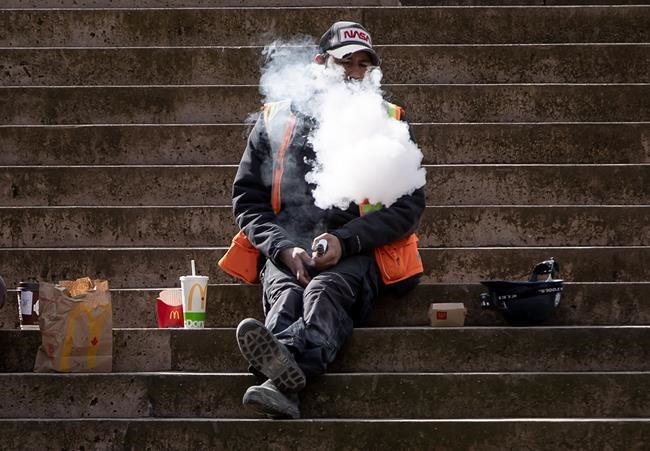Vaping rates among Canadian youth appear to have plateaued in 2020, a Statistics Canada study suggests, which one researcher calls a promising sign that the next generation could be kicking the nicotine habit.
According to a report released Wednesday, about one in seven young Canadians reported vaping on a regular basis last year, a level roughly on par with the data the agency collected in 2019.
Researchers found 14 per cent of teenagers aged 15 to 19 had vaped in the previous month, and the prevalence among young adults aged 20 to 24 was 13 per cent.
By contrast, the data shows only three per cent of adults aged 25 or older say they used e-cigarettes within the previous month.
University of Waterloo professor David Hammond said the numbers indicate that the surge in youth vaping in recent years could be tapering off because of stricter regulations, rising awareness of the health risks and lifestyle changes related to the COVID-19 pandemic.
"It looks like we may have reached the peak of youth vaping," Hammond said. "I would expect that vaping will continue to decline among young people, and if that happens in parallel with the continued reduction in smoking, then that's very good news for everybody."
But one anti-smoking advocate is urging governments to redouble their efforts to tackle youth vaping, because while rates may have levelled off, they remain too high.
"It's good that the rates aren't going up. But at this point, we still have over 400,000 youth who are vaping across the country," said Les Hagen, executive director of Action on Smoking and Health.
"What's frustrating here is that this epidemic of youth vaping continues to rage, and that governments are not attacking the problem as quickly and strongly as they should be."
The numbers in Statistics Canada's 2020 Tobacco and Nicotine Survey are based on the responses of 8,112 Canadians collected between December 2020 and January 2021.
Last year's smoking and vaping patterns can also in part be attributed to shifts brought on by the COVID-19 crisis, but the impacts aren't clearcut, Hammond said.
About one in 10 Canadians reported being regular cigarette smokers in 2020, but prevalence declined overall compared to 2019, according to the study. Young adults aged 20 to 24 saw the biggest dip, with eight per cent saying they were smokers in 2020 compared 13 per cent the previous year.
For some, lockdown has allowed more opportunities to light up at home, he said. And while many people have used the pandemic as an opportunity to cultivate healthier habits, others are turning to familiar vices to cope, he added.
Stress reduction ranked highly among young Canadians' reasons for vaping, with 24 per cent of participants aged 20 to 24 citing it as their primary motivation, a 10 per cent jump compared to 2019.
Hammond said the shuttering of schools in many parts of the country has cut many young people off from the influence of their peers, who often act as e-cigarette suppliers. Moreover, he said, it's more difficult for kids to sneak a puff while stuck at home with their parents.
"For young people, there's probably a greater likelihood that they would reduce both vaping and smoking. Because again, you're not with your buddies," said Hammond. "It's just a lot less cool to be smoking on the back porch with your mom."
Hammond said the spread of a respiratory illness may also be making people more conscious of the health risks linked to e-cigarettes, including vaping-related lung disease.
He said the Statistics Canada findings could also signal the success of government strategies to curb soaring youth vaping rates after Ottawa opened the door for international products to enter the Canadian market in 2018.
Since then, both federal and provincial authorities have introduced tougher restrictions to reverse the troubling trend.
In December, the federal government proposed to reduce the amount of nicotine allowed in vaping products as part of greater efforts to reduce their appeal to young Canadians.
Health Canada also enforced a ban on vaping advertisements in places young people can access also took effect last year.
In a statement Wednesday, the federal regulator said it is considering further measures to deter youth vaping, including restricting flavours.
Many provinces have implemented their own anti-vaping measures, including increasing taxes, restricting the sale of youth-friendly flavours and cutting nicotine content.
This report by The Canadian Press was first published March 17, 2021.
Adina Bresge, The Canadian Press


